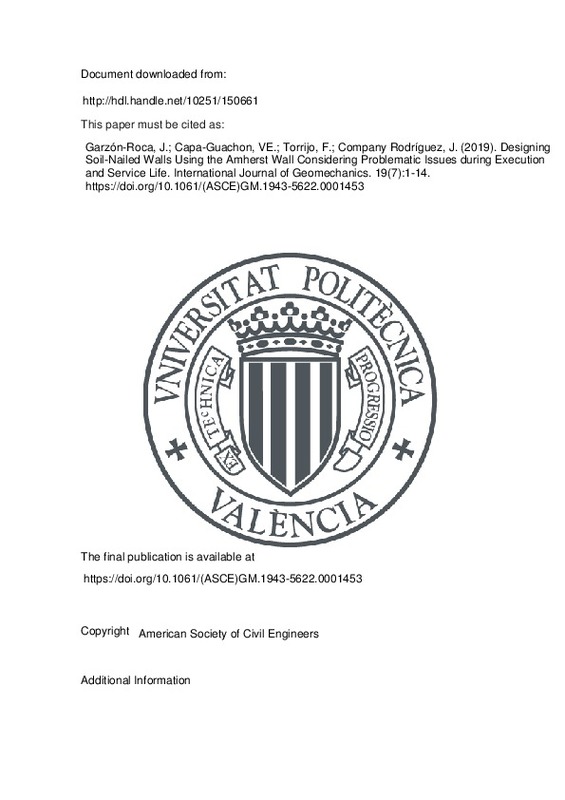JavaScript is disabled for your browser. Some features of this site may not work without it.
Buscar en RiuNet
Listar
Mi cuenta
Estadísticas
Ayuda RiuNet
Admin. UPV
Designing Soil-Nailed Walls Using the Amherst Wall Considering Problematic Issues during Execution and Service Life
Mostrar el registro sencillo del ítem
Ficheros en el ítem
| dc.contributor.author | Garzón-Roca, Julio
|
es_ES |
| dc.contributor.author | Capa-Guachon, Vicente Eduardo
|
es_ES |
| dc.contributor.author | Torrijo, F.J.
|
es_ES |
| dc.contributor.author | Company Rodríguez, Julio
|
es_ES |
| dc.date.accessioned | 2020-09-24T12:29:51Z | |
| dc.date.available | 2020-09-24T12:29:51Z | |
| dc.date.issued | 2019-07 | es_ES |
| dc.identifier.issn | 1532-3641 | es_ES |
| dc.identifier.uri | http://hdl.handle.net/10251/150661 | |
| dc.description.abstract | [EN] Soil nailing is a technique commonly used as a temporary or permanent earth-retention system in soft soils. Habitually, the design of a soil nailing focuses on its performance at failure and computing a safety factor, thus neglecting ground deformations. In this study, an analysis and a comparison of the convenience of the use of the limit-equilibrium method and the FEM for designing a soil nailing were conducted. The assessment considered both the suitability of an easy and fast design process and the necessity to take into account such issues as ground deformations to avoid problematic consequences that can arise during the execution phase and service life. For performing the analyses, a numerical study of the Amherst wall, a full-scale soil-nailed wall built to be an experimental test in the last years of the twentieth century, was carried out. A two-step process for designing soil-nailed walls is proposed. The first step involves the use of limit-equilibrium methods to define the main parameters. The second step deals with the development of a finite-element model to consider ground deformations and determine nail forces. An approach based on the use the Mohr-Coulomb model for simulating materials more similar to granular soils and the hardening soil model for simulating materials more similar to cohesive soils is also presented as an answer for the numerical modeling of soil-nailed walls in ground situations where the soil is neither purely cohesive nor purely granular. | es_ES |
| dc.language | Inglés | es_ES |
| dc.publisher | American Society of Civil Engineers | es_ES |
| dc.relation.ispartof | International Journal of Geomechanics | es_ES |
| dc.rights | Reserva de todos los derechos | es_ES |
| dc.subject | Soil nailing | es_ES |
| dc.subject | Performance at failure | es_ES |
| dc.subject | Ground deformations | es_ES |
| dc.subject | Execution phase | es_ES |
| dc.subject | Service life | es_ES |
| dc.subject | Numerical simulation | es_ES |
| dc.subject | Finite-element modeling | es_ES |
| dc.subject | Limit-equilibrium method | es_ES |
| dc.subject.classification | INGENIERIA DEL TERRENO | es_ES |
| dc.title | Designing Soil-Nailed Walls Using the Amherst Wall Considering Problematic Issues during Execution and Service Life | es_ES |
| dc.type | Artículo | es_ES |
| dc.identifier.doi | 10.1061/(ASCE)GM.1943-5622.0001453 | es_ES |
| dc.rights.accessRights | Abierto | es_ES |
| dc.contributor.affiliation | Universitat Politècnica de València. Departamento de Ingeniería del Terreno - Departament d'Enginyeria del Terreny | es_ES |
| dc.description.bibliographicCitation | Garzón-Roca, J.; Capa-Guachon, VE.; Torrijo, F.; Company Rodríguez, J. (2019). Designing Soil-Nailed Walls Using the Amherst Wall Considering Problematic Issues during Execution and Service Life. International Journal of Geomechanics. 19(7):1-14. https://doi.org/10.1061/(ASCE)GM.1943-5622.0001453 | es_ES |
| dc.description.accrualMethod | S | es_ES |
| dc.relation.publisherversion | https://doi.org/10.1061/(ASCE)GM.1943-5622.0001453 | es_ES |
| dc.description.upvformatpinicio | 1 | es_ES |
| dc.description.upvformatpfin | 14 | es_ES |
| dc.type.version | info:eu-repo/semantics/publishedVersion | es_ES |
| dc.description.volume | 19 | es_ES |
| dc.description.issue | 7 | es_ES |
| dc.relation.pasarela | S\386797 | es_ES |







![[Cerrado]](/themes/UPV/images/candado.png)

